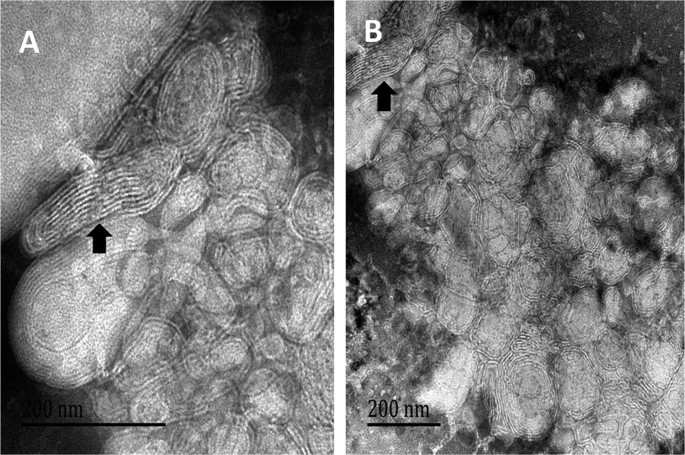Nanocochleates
Nanocochleates are unique lipid-based supramolecular assemblies composed of a negatively charged phospholipid and a divalent cation. With a deep understanding of the drug delivery system, it has been found that nanocochleates have many excellent properties, such as good biocompatibility and optimistic therapeutic efficiency. Therefore, nanocochleates are considered to be a very promising oral delivery vehicle.
Background of Nanocochleates
 Fig.1 TEM image of nanocochleates.1,2
Fig.1 TEM image of nanocochleates.1,2
Nanocochleates are stable phospholipid precipitates derived from the physical interaction of divalent cation (Ca2+ and Mg2+) with anionic lipid vesicles. They are composed of a continuous, solid, lipid bilayer sheet which rolls up in a spiral fashion to form the multilayered cylindrical structures without internal aqueous space. Nanocochleates can be prepared by adding calcium chloride to the preformed vesicles, and it differs from the vesicles in that it has a water-free interior, rod-like and rigid structure.
This lipid-based nanocochleates system has greater potential for the development of innovative pharmaceuticals due to its many advantages, such as good biocompatibility, favorable therapeutic efficacy, ease and safety of production and reduced side effects. Nanocochleates structure is resistant to penetration of oxygen and is therefore less susceptible to oxidation of encochleated molecule. Because the entire nanocochleate structure is a series of solid layers, components within the interior of the nanocochleate structure remain intact, even though the outer layers may be exposed to harsh environmental conditions.
Mechanism of Delivery of Nanocochleates
Nanocochleates have the ability to target macrophages and neutrophils, which contain membrane phosphatidylserine (PS) receptor that delivers nanocochleates through phagocytes. Thus, the encochleated material is delivered to the cytosol of the target cells. To date, these novel carriers have been successfully used to deliver several classes of drugs, including antibiotics, antifungals, antileprosy, anticancer drugs, proteins and DNA subunits, to enhance their therapeutic efficacy.
Nanocochleates formulation technology is particularly suitable for macromolecules as well as the drugs that are hydrophobic, positively or negatively charged and rapid first-pass metabolism, degradation at physiological conditions, proteins and peptides. Therefore, it is meaningful to improve the anticancer activity and reduce systemic toxicity of anticancer drugs by developing nanocochleates drug delivery system. In addition, nanocochleates can attain active targeting which is expected to lead to higher intratumoral accumulation. This can be achieved by conjugating targeting moieties or ligands to the outer surface of the nanocochleates that specifically binds to receptors that are uniquely expressed or overexpressed on the surface of tumor cells but have low or negligible expression in normal cells.
Advantages of the Nanocochleates System
-
Has good biocompatibility
-
A very low side reaction
-
Easy to operate and mass production
-
High security
Our Services for Nanocochleates Formulation
You only need to provide drugs or other molecules, and Creative Biolabs offers tailor-made services according to your needs. In addition, our services include, but are not limited to, the following technologies:
-
Preparation of calcium bridged nanocochleates
-
Evaluation of drug-loaded nanocochleates
-
Pharmacokinetics and anticancer study
-
Tissue biodistribution study
-
Stability test under storage condition
Creative Biolabs offers novel formulations based on nanocochleates that combine the unique properties of a biodegradable material and nanocochleates for biomedical applications. If you provide us with your drugs or other molecules, we are sure to give you the best nanocochleates formulation in the world.
References
-
Liu, Min, Xiaoming Zhong, and Zhiwen Yang. "Chitosan functionalized nanocochleates for enhanced oral absorption of cyclosporine A." Scientific reports 7.1 (2017): 41322.
-
under Open Access license CC BY 4.0, without modification.

For Research Use Only. Not For Clinical Use

 Fig.1 TEM image of nanocochleates.1,2
Fig.1 TEM image of nanocochleates.1,2
 For Research Use Only. Not For Clinical Use
For Research Use Only. Not For Clinical Use


